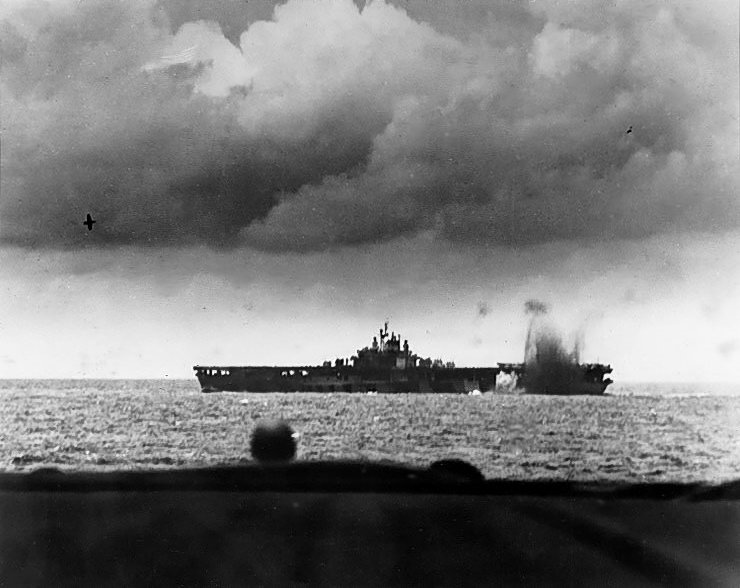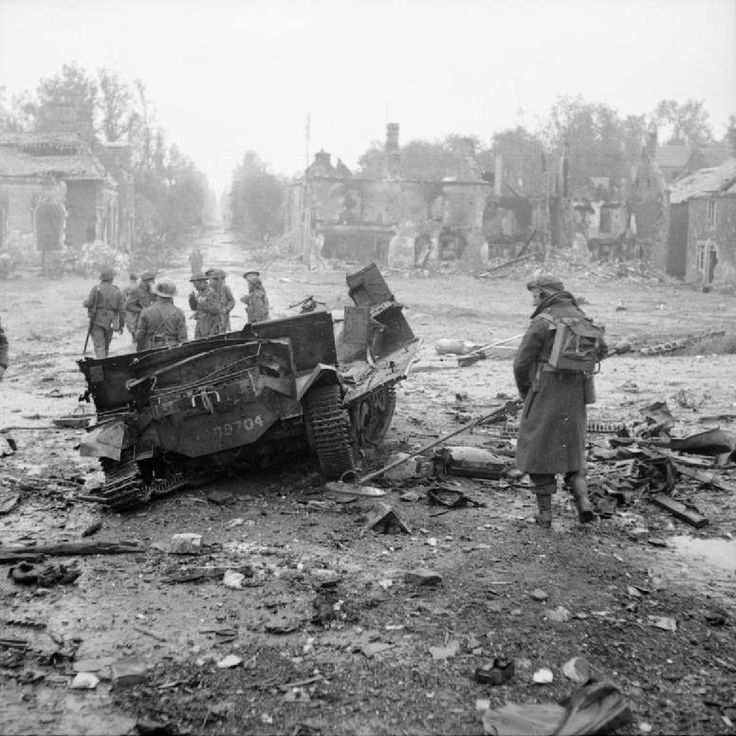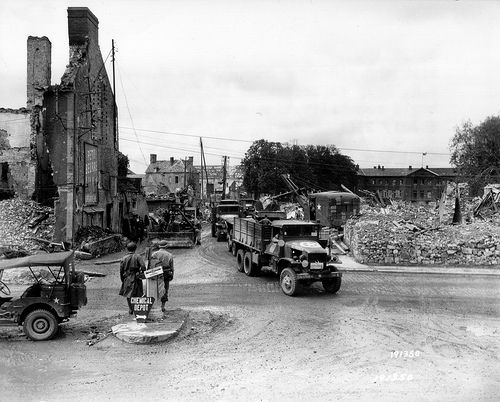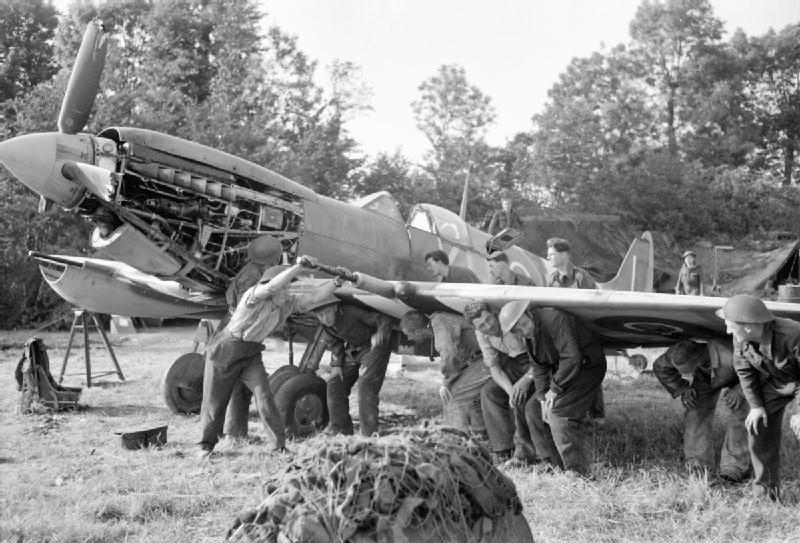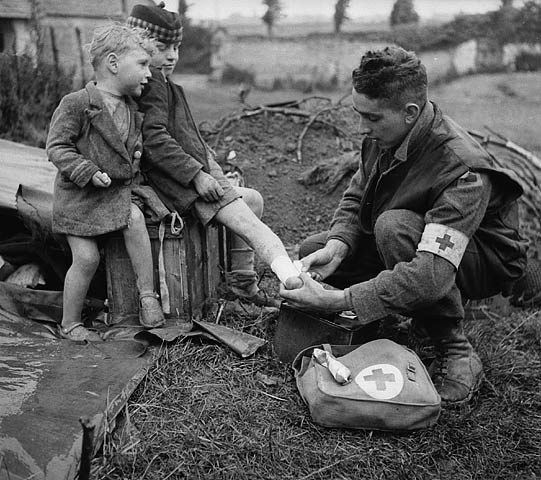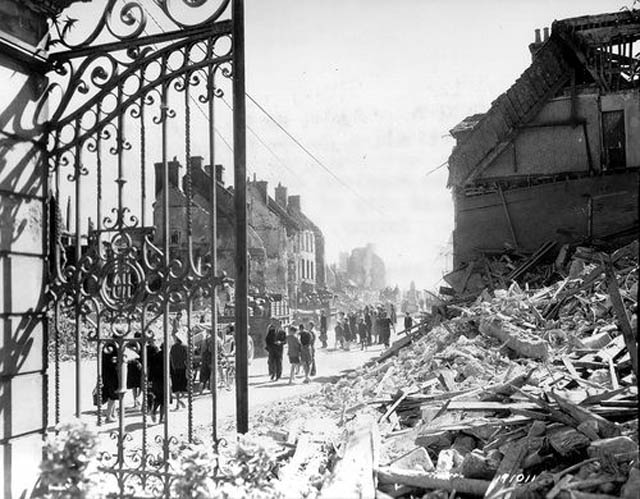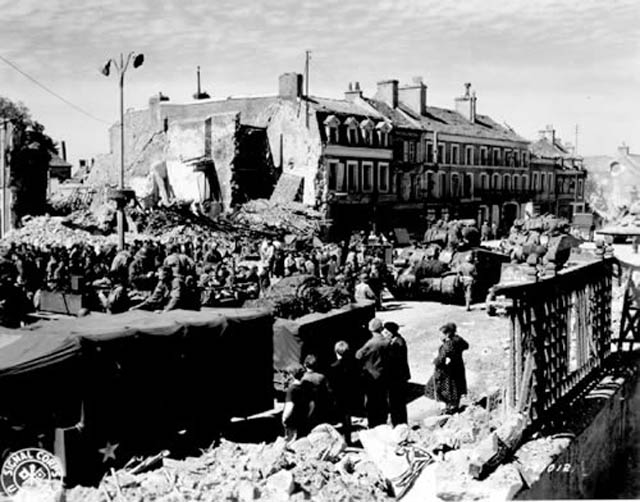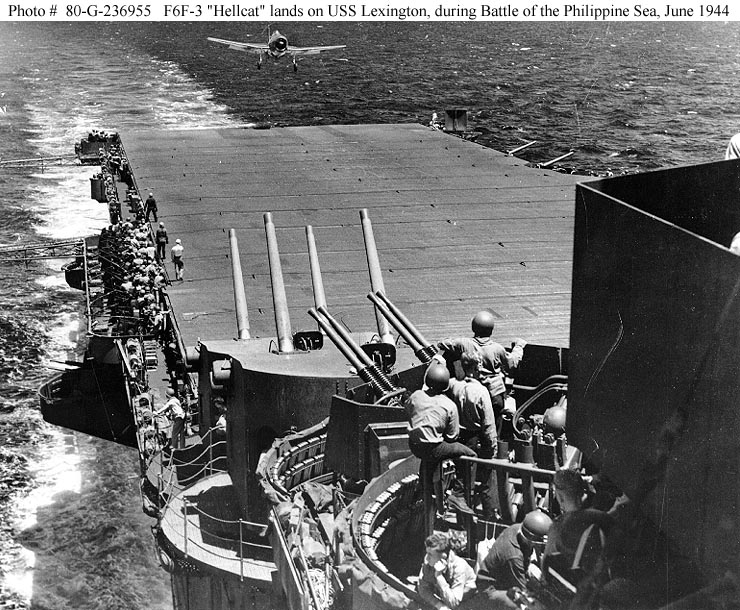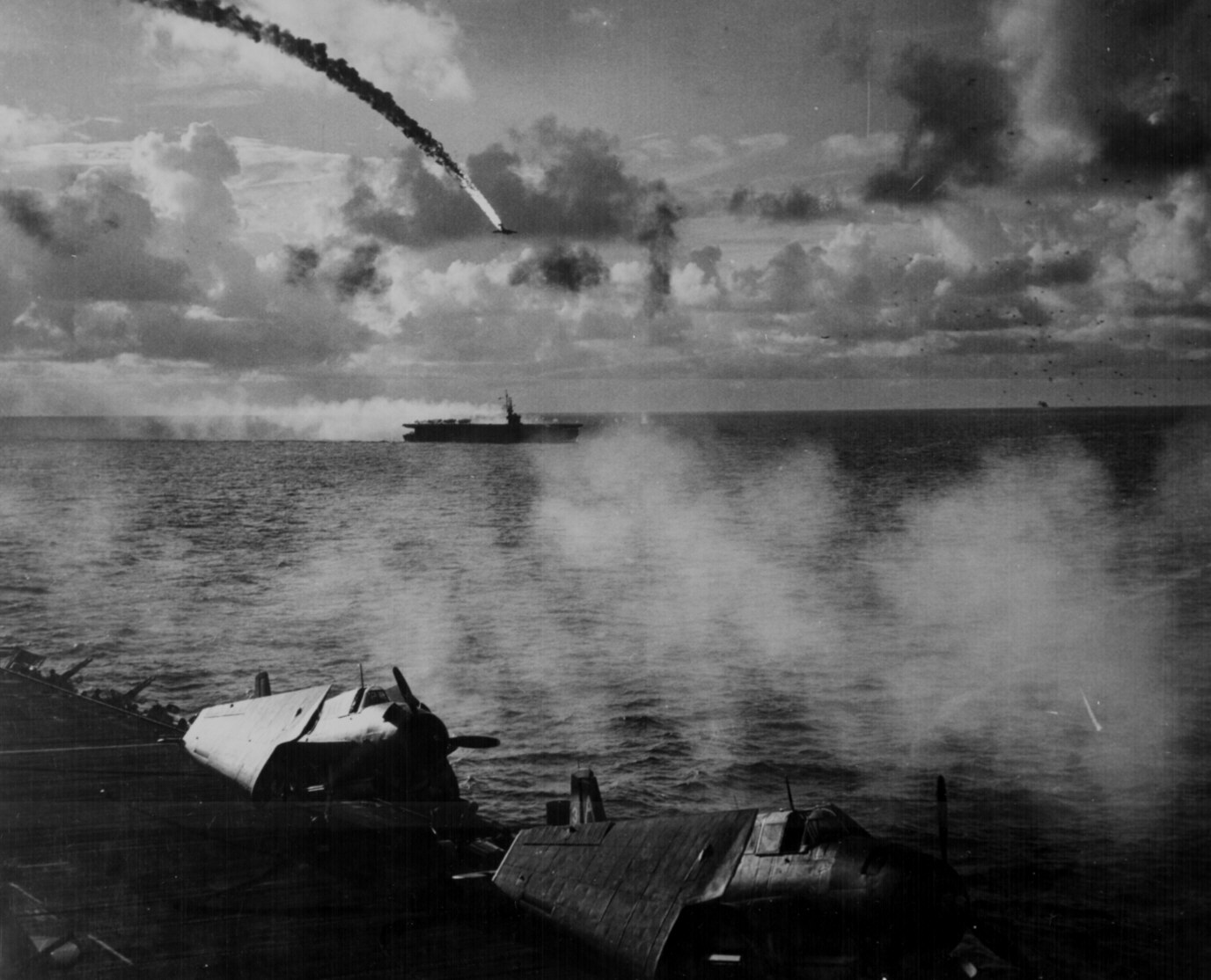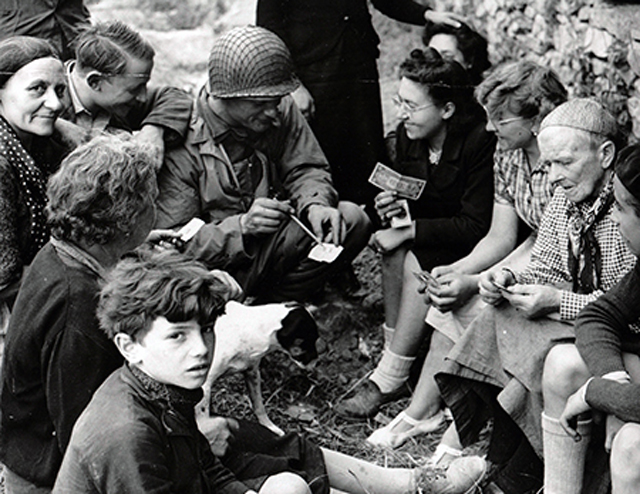Air Operations, Carolines
During the morning, a total of 56 VII and XIII Bomber Command B-24s attack the Truk Atoll, but the effort is too late to prevent Truk’s entire Japanese Navy air complement—4 light bombers and 15 A6M Zeros—from taking off for service on Guam.
[Air Operations, CBI
BURMA- 33 10th Air Force fighter-bombers attack Mogaung, Myitkyina, and Pinbaw.
- 14th Air Force fighter-bombers complete nearly 150 sorties against numerous targets in the Tungting Lake region.
- 18 P-40s attack fuel trucks and two bridges at Yuncheng.
- 15 P-40s attack military camps and motor vehicles in the Salween River area.
- A 449th Fighter Squadron P-38 downs a D3A 'Val' dive bomber near Changlokai at about 0645 hours.
- 30 10th Air Force B-25s airlift ammunition to Imphal.
- 4 341st Medium Bomb Group B-25s attack a bridge at Kengluang.
Air Operations, Europe
RAF BOMBER COMMANDDaylight Ops:
- After standing by for 3 days waiting for cloud over the Pas de Calais to clear, 19 Lancasters and 2 Mosquitos of No. 617 Squadron, with 9 Mosquitos of No. 8 Group providing preliminary marking, attack the flying-bomb store, but the conditions are too difficult for accurate marking and the nearest Tallboy bomb lands 50 yards from the concrete store.
FRANCE:
- Despite heavy cloud cover that results in more than 200 aborts, a total of 261 8th Air Force B-17s attack the Bordeaux/Merignac, Cabanac, Cazaux, Cormes Ecluse, and Lanes-de-Bussac Airdromes.
- 5 B-17s are lost over Bordeaux/Merignac, 2 are interned in Spain
- Escort for the bombers attacking the airdromes is provided by 88 P-38s and 261 P-51s.
- 4 P-38s and 6 P-51s are lost with their pilots
- Also during the morning, despite bad weather that results in nearly 400 aborts, two mixed formations aggregating 216 8th Air Force B-17s and 294 B-24s using GH radar attack V-weapons sited in and around the Pas-de-Calais area.
- Escort is provided by a total of 715 VIII Fighter Command fighters.
- Following its escort assignment, one P-38 group dive-bombs and strafes several transportation targets.
- No bombers or fighters are lost
FRANCE:
- Nearly 200 9th Air Force fighter conduct patrols over France during the morning.
- During the afternoon, 9th Air Force fighter-bombers attack six V-weapons sites.
- The IX TAC's 368th Fighter Group becomes the first USAAF unit to be permanently assigned to a base in France -- Advance Landing Ground A-3, at Cardonville, a crude wire-mesh runway that has been constructied by an engineer avaiation battalion overseen by the IX Engineer Command.
ITALY:
- Bad weather grounds the bombers of the 12th and 15th Air Forces, but fighters of the 12th Air Force's 87th Fighter Wing support the Free French Army ground units on Elba Island during the afternoon.
- XII TAC fighter-bombers are able to attack gun emplacements, a factory, some coastal shipping, and several rail lines in north-central Italy, also during the afternoon.
Air Operations, Mariana
- In the main engagement of history’s fifth carrier-versus-carrier engagement—the Battle of the Philippine Sea—Task Force 58 is engaged by a force of as many as 430 Japanese carrier aircraft, many of which shuttle through land bases in the Marianas.
- In the day’s first aerial engagement, at 0547 hours, 2 VF-16 F6Fs down 1 of 2 carrier-based reconnaissance D4Y 'Judys' encountered at sea. At 0550 hours, an A6M Zero fighter-bomber based at Guam attacks 2 US picket destroyers to the west of Task Force 58. The bomb misses 1 destroyer and the Zero is downed by a second destroyer. Next, at about 0630 hours, Task Force 58 radars locate a large flight of Japanese Navy aircraft over Guam, and F6Fs are sent to intercept. It is believed that these are many of the remaining Japanese Navy aircraft still based at Guam and possibly other land-based aircraft dispatched from other islands. In a series of continuous engagements between 0630 hours and 1005 hours, US F6Fs and FMs, and several US bomber crews, down 49 of these land-based Japanese Navy fighters and bombers, mainly at sea and over Guam, but also a number of B5N 'Kate' search aircraft launched from Japanese carriers.
- At 0910 hours, while launching her strike force, the fleet carrier Taiho—the Combined Fleet’s newest carrier—is mortally damaged by the submarine USS Albacore. She will sink at 1700 hours, following the detonation of gasoline fumes by ill-trained damage-control teams.
- In all, beginning at 0830 hours and including aircraft launched from the Taiho, Japanses carriers send 48 B5N 'Kate' torpedo bomber and B6N torpedo bomberss, 89 D3A 'Val' dive bombers and D4Y 'Judy' diver bombers, and 189 A6M Zero fighters and fighter-bombers organized into four attack groups. The first of these appear on USN radars at 0950 hours while still 130 miles from Task Force 58.
- As soon as the incoming Japanese Navy aircraft are fixed on radar, all US fighters—an estimated 475 in all—are recalled from combat strikes or launched from carrier decks. To eliminate a major fire hazard, all Task Force 58 light bombers (192 TBMs, 174 SB2Cs, and 59 SBDs) are concentrated 100 miles from the fleet and 200 miles off Guam.
- The main battle for the US carriers begins at 1025 hours and sputters to a close at about 1215 hours. It is a complete rout. Several hundred Japanese Navy fighters, fighter-bombers, and light bombers are downed by US Navy F6Fs and FMs.
- At 1049 hours, a Japanese Navy carrier bomber from the first attack force scores a direct hit on the battleship USS South Dakota, which sustains casualties of 27 killed and 23 wounded. This is the only direct hit scored by a Japanese airplane during the entire battle. At about noon, an incendiary bomb that bursts over the USS Wasp noon kills 1 and wounds 12. 1 of 2 near misses dropped by second-strike D4Y 'Judy' dive bombers on the USS Bunker Hill kills 3 and wounds 73.
- At 1220 hours, 3 torpedoes fired by the submarine USS Cavalla mortally damage the fleet carrier Shokaku, the fifth of the six carriers participating in the Pearl Harbor attack to be sunk.
- In addition to taking on the incoming Japanese carrier strikes, US carrier aircraft have a busy day attacking ground targets on various islands. At abut 1100 hours, 17 VB-2 SB2Cs and 7 VT-2 TBMs, escorted by 12 VF-2 F6Fs, attack the Orote airfield on Guam without opposition. At about 1300 hours, VB-16 SBDs circling to avoid being drawn into the action over the carriers, mount an ad hoc attack, also against the Orote airfield. This precipitates orders for all of the several hundred orbiting US carrier bombers to attack the Orote airfield and the nearby Agana airfield. Also, 11 VB-15 SB2Cs attack the Orote airfield again at 1400 hours.
- Several small Japanese strike groups attempt to attack Task Force 58 between 1300 hours and about 1430 hours, but most of these aircraft are downed.
- Next, beginning at about 1500 hours, rearmed and refueled US carrier bombers and F6Fs mount several attacks against island airfields. As F6F strafers are recovering from a low-level attack against the Orote airfield on Guam, 49 fuel-starved Japanese carrier bombers and fighters from the fourth strike force (that were unable to locate Task Force 58) arrive over the base. Most of these aircraft are shot down or destroyed after landing. Other Japanese Navy aircraft are downed in a late-afternoon engagement at sea near Guam.
- By day’s end, the Japanese Navy counts 340 to 400 of its aircraft lost, while Task Force 58 losses are just 17 carrier aircraft in aerial combat, 8 others to antiaircraft fire during attacks on Guam, and 7 in operational accidents. 1 US battleship and 1 cruiser are damaged by Japanese aircraft, and 2 Japanese carriers are sunk by US submarines. Also, a VT-60 TBM sinks the submarine I-184 with depth bombs.
- The so-called Marianas Turkey Shoot is the best day US Navy fighters have ever had: Credits for 380 confirmed victories and 55 probable victories are awarded.
- 20 US Navy pilots and 7 air crewmen are lost. Casualties aboard US ships hit or near missed are 31 killed.
Air Operations, New Guinea
- V Bomber Command A-20s attack airfields at Manokwari, Moemi, and Noemfoor Island.
- More than 100 A-20s and V Fighter Command fighter-bombers attack supply dumps, bivouacs, roads, and gun emplacements in the Wewak area.
Atlantic
The US vessel LST-523 hits a mine and sinks in the Normandy area.
[Battle of the Atlantic
The salvaged U-boat, U-505, which was captured June 4, is secretly towed to Great Sound, Bermuda by the fleet tug Abnki.
[Battle of the Philippine Sea
Early in the morning the Japanese search finds TF 58, at the same time remaining unsighted themselves. At once the Japanese carriers launch 4 waves of attack aircraft numbering altogether 372. In numbers of planes the comparison is overwhelmingly in favor of the Americans - about 950 to 550 (including, for the Japanese, landbased aircraft). The American fleet is well disposed to meet air attack. The battleships are sailing slightly to the west to provide a large AA barrier and with the help of radar there is no question of surprise. Early on the Americans have time to send a strike against Guam further reducing the air force there. When the Japanese attacks are detected coming in fighters are sent out to meet them and the bombers are flown off to clear the carrier decks. The fighters make interceptions up to 50 miles out and shoot down many of the attackers. Still more are shot down by the ships' gunfire and only a handful actually make attacks. The battleship South Dakota (BB-57) receives damage - one bomb hit from a dive bomber. Other US ships damaged during the battle: the battleship Indiana (BB-58( from a suicide plane; the carrier Bunker Hill (CV-17) from a dive bomber; the carrier Wasp (CV-18) from a dive bomber; the heavy cruiser Minneapolis (CA-36) from a horizontal bomber; the destroyer Hudson (DD-475) by friendly gunfire; the motor minesweeper YMS-323 from coastal gunfire; and the ocean tug ATR-15 from grounding. The Japanese lose 240 aircraft and the Americans only 29.
More Japanese planes are destroyed before landing on Guam and most of those that survive are hit on the ground - 50 machines in all. The list of Japanese misfortune is completed when, soon after launching their aircraft, the carriers Shokaku and Taiho are sunk by the US submarines Cavalla (SS-244) and Albacore (SS-218) respectively. These have been 2 of the largest and most effective Japanese ships. The Japanese have succumbed so easily that the day is described by the American airmen and gunners as 'The Great Marianas Turkey Shoot'.
[CBI
BURMAOn the Salween front, Ku-tung falls to elements of the Chinese 2nd Reserve Division pushing to the south toward Teng-chung. The Chinese 53rd Arm is preparing to attack Chiangtso.
[Eastern Front
In a massive, co-ordinated sabotage operation, 100,000 Soviet partisan guerillas detonate more than 1,000 explosions in the rear of German Army Group Center positions. Supply and communications are inoperable for days.
In preparation for Operations BAGRATION, the 350,000 partisans operating behind Army Group Center attack German railway lines. In total, the partisans lay 15,000 demolition charges on the railway lines running through the area and blow up 10,500 lengths of track during the night. Their main effort is directed against the supply lines for the 3rd Panzer Army, the unit that will be the focus of the initial Soviet attack. The partisan attacks result in blocking of all double-track lines for 24 hours, and the disruption in the operation of the single-track lines for 48 hours.
THE PARTISAN WARWith more than 370,000 partisans operating behind Army Group Center, the Soviets plan to paralyze the German railway network, crippling the German ability to coordinate their front line forces and move up reinforcements. Partisans destroy hundreds of miles of railway lines and bring movement to a halt. In addition, the Soviet air armies launch massive strikes against the Luftwaffe bases in Belorussia.
[Indian Ocean
Port Blair in the Nicobars is attacked by aircraft from the carrier Illustrious. Adm A. J. Power is in command and among the supporting heavy units are the Renown and the Richelieu.
[Italy
British units reach the south and east side of Lake Trasimeno. The next German defense line, the 'Albert' Line, is just ahead.
[Marianas
On Saipan the 4th Marine Div, having reached Magicienne Bay on the east coast, turns north, leaving the 27th Inf Div to mop up the Japanese still holding out in the southern part of the island. This is expected to be a straight-forward mopping-up operation, but things turn out very differently.
[Mediterranean
The French Expeditionary Corps completes the occupation of Elba.
[New Guniea
On Biak, after an accurate artillery barrage, the US 186th Inf succeeds in getting behind the Japanese positions in the western caves, cutting the road that leads to the north. The 34th Inf occupies the airfields at Borokoe and Sorido.
[Pacific
The Japanese submarine I-184 is sunk by aircraft (VT-60) from the US escort carrier Suwannee in the Central Pacific area.
[V-Weapons
Further V-1 'flying bombs' fall on southern England. German propaganda magnifies their effect, saying that 'the roads from London are choked with refugees'.
[Western Front
Various American units complete the clearance of Montebourg and Valognes as they begin their final attack on Cherbourg. On the left the 9th Division advances in the direction of Helleville, St Christophe-du-Foc and Couville, in the center the 79th Division makes for the line from Golleville to Urville and Bois-de-la-Brique. On the right of the US line the 4th Division, the farthest advanced, meets with fierce resistance by the German forces defending Cherbourg. The 82nd Airborne Division and the 90th Division are transferred from the VII Corps to the VIII.[WF]
It is officially announced that the British 7th Armored Division - the famous 'Desert Rats' of the North African campaign - is fighting in Normandy.
A storm lasting 4 days beginning this day wrecks the American 'Mulberry' harbor off Omaha Beach and seriously damages the British 'Mulberry' off Arromanches. The American one at Omaha is irreparable but with the help of sections from it the British harbor at Arromanches is made operable. Many landing craft are also sunk or damaged, especially DUKW's.[CAEN]
[Images from June 19, 1944
|
|
|
|
|
|
|
|
|
|
|
|
